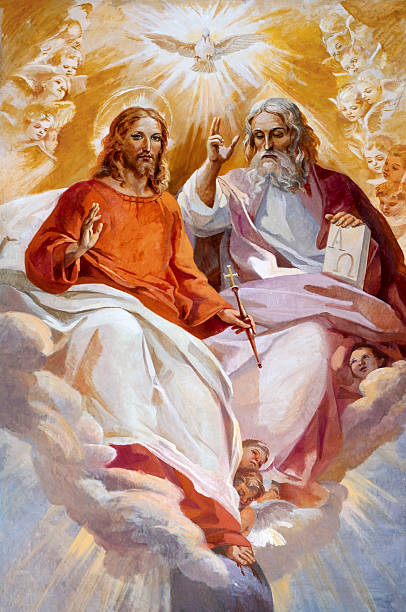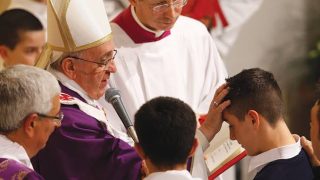
THE CHRISTOCENTRIC ASPECT OF TRINITY
HOMILY FOR THE SOLEMNITY OF THE HOLY TRINITY, YEAR C. Readings: Proverbs 8:22-31; Psalm 8; Romans 5:1-5 and John 16:12-15.
The solemnity of the Holy Trinity is the greatest mystery of our faith and fundamental to Christian faith. This doctrine causes great curiosity among Christians as to the appropriate understanding of how God is, how He relates to us and how we should relate to Him. It is a doctrine that raises various questions such as: how can God be one and three at the same time? If Jesus is God, why did the gospels record times when He prayed to God, or is the Trinity a contradiction? What then is our knowledge of God: Monotheism or Trinitarian? Beginning from a brief historical point of view, we shall reflect on the biblical background and catechesis on Trinity.
Historically, religious divisions came from conflicting beliefs about God, rather than any conflict between theism and atheism. This division has caused many to look keenly to the nature of God. Among the ‘many’ was Arius who fell into heresy, known as the Arian heresy in the fourth century. While attempting to explain the nature of God, he stated that, “If the Father Begat the Son, then he who was begotten had a beginning in existence, and from this, it follows there was a time when the Son was not.” Put differently, his heresy was that, Christ was not fully God and unequal with God the Father. This led to the Ecumenical Council of Nicaea of 325 AD where the Church proclaimed the dogma of the Holy Trinity, affirming that the doctrine of the Trinity holds that God the Father, the Son and the Holy Spirit are one God, but three Divine persons.
From the biblical perspective, the Old Testament often presents a monotheistic idea of God, who stands as the Father and Creator of heaven and earth. The God who said, “Let us make man in our own image and likeness” (Gen 1:26). A conversation that is interpreted to be with God the Son and God the Holy Spirit. It is on this note that the first reading gives us a glimpse of the Trinity. It says, “When there was no depth, the wisdom of God was there; when there was no spring of water, He was there; when he established the heavens, He was there; when he assigned the sea its limit, so that the water might not transgress his command, Wisdom was there…” (Prov. 8:24-27). The wisdom here can be no other person than the Son of God himself, to whom the principal things spoken of wisdom here are attributed to him. Wisdom is personified and draws our attention to the existence of Jesus Christ before time. Wisdom (Christ) is both God the Creator, and at the same time, the witness to creation. Theprologue of John affirms this, “In the beginning was the Word and the Word was with God and the Word was God” (Jn 1:1). The Word (Christ) has been in existence before creation.
Before the emergence of God the Son (Christ) in the New Testament, we only had knowledge of the monotheistic God in the Old Testament and from God the Son; we hear the promise of God the Holy Spirit, who is the sanctifier. Christ in various instances reveals to us the unity and oneness of the Trinity. He said to his disciples, “All that the father has belongs to me” (Jn 16:18); He said to Philip, “I and the father are one” (Jn 14:10); In John 16:13, he said, “When the Spirit of truth comes, he will lead you to the complete truth.” In John 8:38 Christ said, “I tell you, before Abraham ever was, I AM,” which reminds us of the revelation of God the Father to Moses at the burning bush (I AM who I am). Hence, we can claim that our knowledge of the Trinity begins from Christ. It is Christocentric. That is, the feast of the Holy Trinity is the liturgical conclusion, which begins from advent, Christmas and cumulate on Pentecost Sunday. Put differently, in Christ is the fullness of God’s revelation.
The Gospel presents a continuation of Christ’s farewell speech to his disciples with the promise of the Holy Spirit. Last Sunday he said, “But the Counsellor, the Holy Spirit, whom the Father will send in my name, will teach you all things, and bring to your remembrance all that I have said to you” (Jn 14:26). In today’s periscope, Christ said, “I have many things to tell you, but you cannot bear them now. When the Spirit of truth comes, he will guide you to all truth” (Jn 16:12). In other words, the Holy Spirit will bring to completion the work of the Father and the Son. Within these two Sundays, Christ shows us the Unity that exist in the Trinity. The Trinity do not contradict one another, they live in love, their project are the same and they share same glory.
In the second reading, St. Paul affirms the work of the Son who glorifies the Father. Through the Son, we have access to the Father. The Son manifests the love of the Father to humanity when he said, “God’s love has been poured into our hearts through the Holy Spirit who has been given to us”. (Rom 5:5). God the Father is also the Divine Lover. He so loved the world as to give us His only Son (John 3:16), which is an expression of Auto-communication of God. In light of this that we have the fundamental axiom of Karl Rahner’s theology (German theologian of the 20th century on Trinity), that gave good insight to Trinity with the term “Anthropocentrism,” God became man to save humanity, which is the immanent Trinity and Economic Trinity.
Catechetically, the Holy Trinity remains a mystery to us and this mystery is the center of our Christian faith. According to the Catechism of the Catholic Church, “It is the most fundamental and essential teaching in the hierarchy of the truths of faith” (CCC 234). It is a mystery of our faith. In this mystery, there are three figures, the Father, Son and Holy Spirit. There, the figure three symbolizes completeness and perfect symmetry, and re-appears at all the key moments of God the Son. His life itself constantly reflected the Trinity. Three figures make up the nativity scene in Bethlehem, the Holy Family of Jesus, Mary and Joseph. Their first visitors were the three wise men. Later, in the desert preparing to begin his public life, the Son was tempted three times by the devil. The end of his life, as the beginning, has again the three motif. During his Passion, Peter denied him thrice. On the road to Calvary, he fell three times. The crucifixion scene has three figures, Christ between two thieves. Before his resurrection, he spent three days in the tomb. All these events reflects the Holy Trinity, which is always revealed to us in different ways.
Hence, in the Christocentric view of Holy Trinity, God the Son revealed God the Father, and from the Father and the Son we have knowledge of God the Holy Spirit. Inherent lessons in this solemnity are: unity, truth and love. It is a model for a perfect family, community and society. In our uniqueness, we can be united, just as Christ prayed for the unity of the Church two Sundays ago. We must not be selfish or work for our personal gratifications. No member of the Trinity oppresses or takes advantage of the other. So, we must avoid manipulating others but rather, learn from the three Divine Persons how to love and respect one another.
Happy Holy Trinity Sunday!
Fr. Ken Dogbo, OSJ










